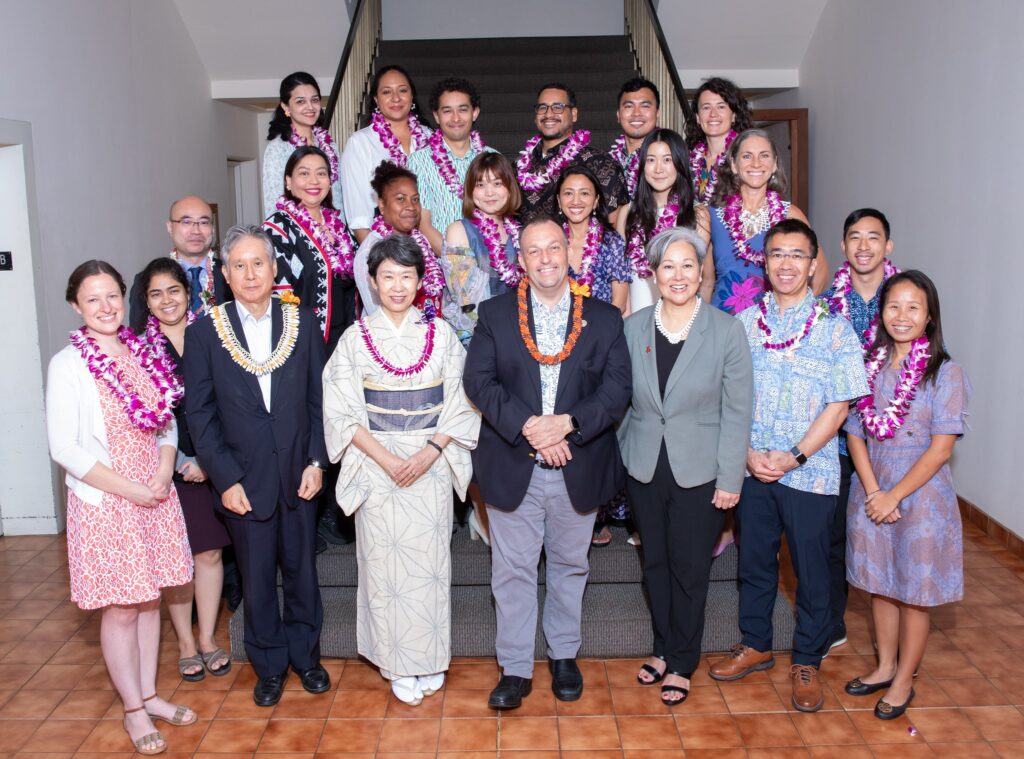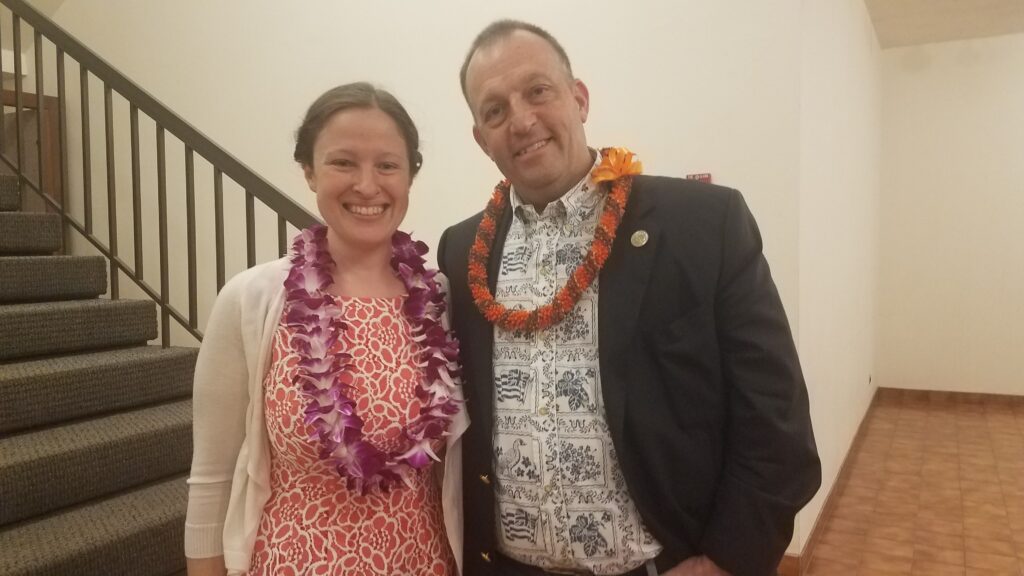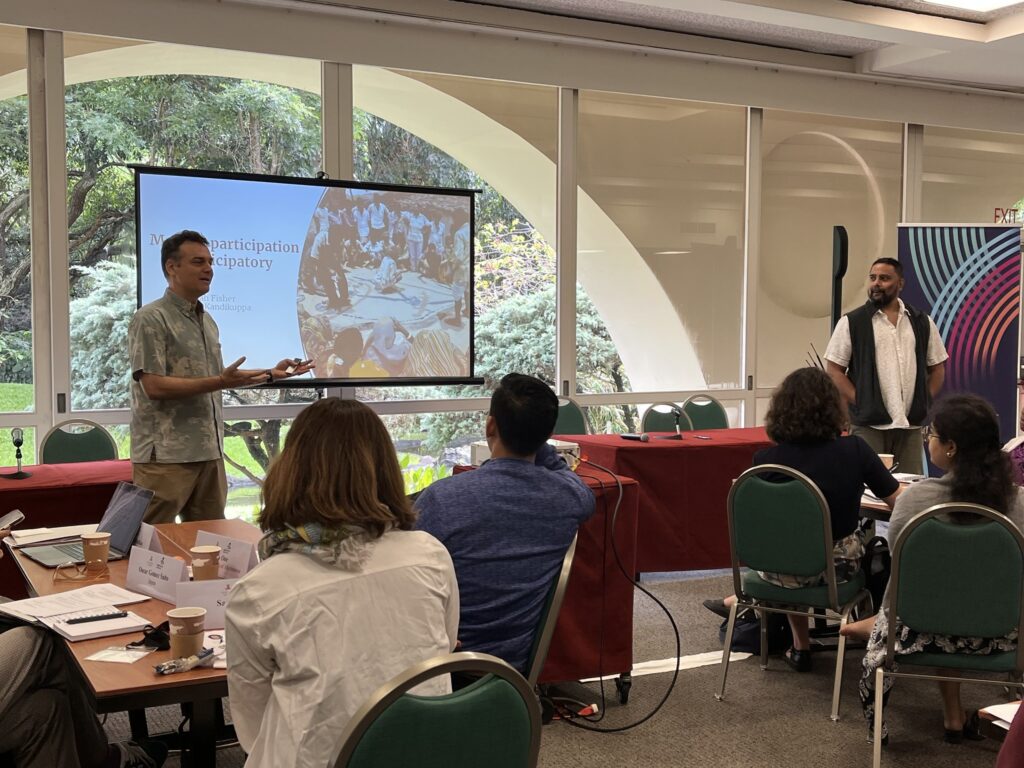<– Start at the beginning of the Climate Lab series
Hawai’i, Part 1 – In the Classroom
“You’re feeling grief. The solution to grief is time + action. Stay educated and make changes.”
– Dr. Charles Fletcher, University of Hawai’i
Heading toward Honolulu at the end of January, on one of the bumpiest flights of my life, I finished up some overdue homework assignments for my climate adaptation leadership lab. One of the last things I would do before meeting the rest of my cohort in person for the first time was watch a sobering presentation about some of the changes we can expect to see across the globe in the years to come as temperatures rise.
These changes included everything from a decrease in habitable land, to a decrease in drinkable water, to a decrease in the nutritional value of cereal grains. In order to avoid the worst of these impacts, University of Hawai’i’s Dr. Charles Fletcher explained, our global greenhouse gas emissions must peak by 2025, and they must drop by 60% by 2035. His next words landed with more weight than I expected: “this decade will determine the future of humanity on this planet.”
Exactly two weeks earlier I had said goodbye to my mom at the end of her battle with breast cancer. If there was anything in the world that could distract me from that pain, it would be addressing an existential threat to our species. And the week to come would be an intense dive into academic research, community field visits, and self exploration, all in service of developing effective approaches to leading climate change adaptation efforts. That much I expected; what I didn’t expect was how strongly and frequently the concept of grief would surface in our studies.

Image courtesy of East-West Center: [1]
Food for Thought
The islands of Hawai’i – being islands – are especially vulnerable in a changing climate. When I think of climate change impacting islands, I primarily think of rising sea levels, even though there are additional threats to contend with, such as increased frequency and intensity of storms, as well as – conversely – droughts, which in turn contribute to wildfires. (And the island of Maui was the site of devastating wildfires just five months prior.) All of these are serious issues that warrant pages of detail on their own, but they also tend to be more front of mind when we think about climate impacts – since they are weather related. What truly shocked me, which we heard in the very first session of the week, directly from the governor of Hawai’i, were the rippling impacts from extreme weather events and the serious consequences felt after the fact, such as access to food and shelter.
Having lived on an island for two years, I understand that it is necessary to import goods to supplement what can’t be produced there, but in Japan I never had a feeling that the situation was in any way precarious. In Hawai’i, on the other hand, we were told that, at any given time, the state has about 10 days of food on hand for residents and tourists, though some estimates project less. It takes several days to ship food from elsewhere, with approximately 3,000 tons per day arriving in Honolulu Harbor – the only port large enough to handle ships of that size. A recent assessment determined that if the port were shut down in a disaster, it would take 19 or more days to fully reopen. [2]
Damage to infrastructure and distribution systems means that even if supplies are available, they cannot necessarily get to where they need to go. There is one road that reaches communities on Oahu’s north shore, a point of concern we heard directly from residents later in the week. And while the focus during our time on Oahu was primarily Oahu, there are six other populated islands in the archipelago, none of which has the level of infrastructure of Hawai’i’s capital. And food isn’t the only imported resource: fuel necessary for inter-island transport will also be a limited resource.

But there’s more to climate risk assessment and management than just the physical limitations of our infrastructure and the severity of the disasters affecting them. The same assessment I referenced above noted “little to no coordination between emergency management agencies and the private sector for emergency food distribution,” making it clear that a major component of climate change risk is how coordinated we are in preparing for and responding to disasters.
Identifying the Problem(s)
When I think of how my work relates to climate change, I think more of mitigation than adaptation, and I recognize that itself is a privileged perspective. Opinions raised during classroom discussions on day one called mitigation a responsibility for “rich and polluting countries,” while adaptation was a necessity for countries that feel the brunt of impacts they didn’t create. Long-time readers of this blog know that I always try to consider the impacts of my decisions, but that mental energy still usually goes to thinking about how I can reduce my impact on the planet and others’ lives, not how my life is impacted by others.
Given all that, I fully appreciated the irony of flying around the world to participate in a program focused on climate change. Travel, particularly air travel, is a huge component of greenhouse gas emissions worldwide, and tourism is one of the two largest drivers of climate change in Hawai’i (the other being military activities). But although it contributes to climate impacts and exacerbates economic disparities, Hawaiian tourism also makes up about one fifth of the local economy. Pre-pandemic, over 10 million visitors a year spent almost $18 billion across the state, [3] and that level of revenue cannot be easily cast aside, despite the need for the current system to evolve.
Government, non-profit organizations, private companies, and residents alike experience a mix of benefits and drawbacks from the tourism industry. Aside from greenhouse gas emissions from plane travel to the islands and the import of food and other supplies to support tourism, we are seeing ecological impacts in high traffic areas (such as coral reefs [4]), as well as degradation of community cohesion with the increased presence of independently owned vacation rental properties in residential areas. But any conversations about making changes to a major revenue driver will be unpopular with anyone making money from the current structure. All that said, as anyone with a background in sustainability knows, longer-term thinking is better for business – and, when conveyed effectively, illustrating the benefits of an improved, more forward-thinking approach can help gather support for a given course of action.

(He’s also from Pittsburgh!)
In his presentation, the governor described policy-based attempts to address some of these concerns, such as issuing a $25 climate tax for visitors [5] and placing restrictions on vacation rentals that would keep more tourists in tourist areas and residents in residential areas. But in our discussions with him and others later, we recognized that those are only a piece of the larger issue of climate vulnerability across the state, and a top-down approach through the bureaucratic machine can’t be the only method to address the myriad risk factors that exist, some of which require a more nimble, non-governmental approach. When it comes to addressing such a large and complex issue, we already know it’s going to take multiple efforts from multiple angles at multiple scales, preferably coordinated.
Participatory Processes
In order to develop approaches that work for everyone involved, it is critical to get input from a wide array of people who will be impacted by a given decision, as I’ve described previously in posts on this subject. [6] As one of my classmates so succinctly put it, “to lose diversity is to lose an answer.” But attempts to gather that feedback, even from a diverse group of stakeholders, can meet with varying levels of success. Before we went out to learn from impacted communities that week, we explored various approaches and considerations to keep in mind when listening to stakeholders.
I imagine I’m not the only person in the world who has rushed toward a seemingly “right” answer only to find that there were factors I hadn’t even thought to consider, and that the result could have been far more successful with one or more people there at the beginning to point out blind spots or incorrect assumptions. In rushing to develop solutions to this existential crisis we find ourselves in, we cannot afford to cut corners on first defining the problem that needs to be solved. Over years of community work I have learned from experience that what I’ve identified as a top priority to address for others’ benefit may not even be a priority issue they’ve identified for themselves. And the greater the space between my assumptions and their actual lived experience, the less useful any of my efforts will be.

Image courtesy of East-West Center: [7]
Before heading out to our site visits, we were encouraged to keep in mind the role of trust in building relationships: being authentic about why we’re there and what our goals are, listening effectively to better understand their concerns, and knowing to whom we need to be accountable before, during, and after these engagements. I know from my own work, but it always bears repeating, that no two communities are the same, and no one person ever speaks for an entire community as a monolith. Valuing each individual’s contribution is critical, but it’s also just as critical to remember that each story is not the whole story.
The level of meaningful participation required for effective climate change adaptation will be enormous and messy, and for that reason, we will all need constant, consistent overcommunication about what we’re doing and why just to keep track of everything that’s happening. Even for me, going into this week with years of community engagement experience, I was still unprepared for some of what I saw during our field visits. And that’s where we’ll pick up next week.
Thank you for reading!
The Indo-Pacific Leadership Lab [8] is a program of the East-West Center, [9] with support from the Japan Foundation. [10]
As always, content on this blog reflects my personal views, and not those of any organization with which I am associated.
[1] https://www.flickr.com/photos/eastwestcenter/albums/72177720315300633/
[2] https://seagrant.soest.hawaii.edu/how-food-secure-are-we-if-natural-disaster-strikes/
[5] https://www.usatoday.com/story/news/politics/2024/02/19/hawaii-tourist-climate-tax/72664025007/
[6] https://radicalmoderate.online/climate-lab-diversity-inclusivity-and-equity/
[7] https://www.flickr.com/photos/eastwestcenter/albums/72177720315300633/
[8] https://www.eastwestcenter.org/projects/indo-pacific-leadership-lab
0 Comments